Volkswagen Tiguan Service and Repair Manual: Tire Wear
Tire Service Life, Influences
The following factors influence the service life of a tire in varying degrees.
Driving style:
- Speed
- Brakes
- Acceleration
- Cornering
Service;
- Tire Pressure
Area:
- Paving
- Exterior temperature/climate
Vehicle:
- Weight
- Dynamic toe and camber values
Tire Operating Conditions
- Speed range
- Wet or dry
Tire Construction:
Winter/summer
Changes to the Suspension:
If a "lowering-kit" and /or light alloy wheels from accessories which have not been approved by the vehicle manufacturer are used, wheel alignments which deviate from the alignment specified in design may occur during travel.
Even if the adjustment of the axle geometry measured on a standing vehicle is correct, changes in the body height and positions of the wheels during travel can lead to changes to the paths of travel of the wheel suspension.
For this reason, uneven wear is pre-programmed.
Heel and Toe Wear
Heel-and-toe wear is step-like wear of individual tread blocks, due to which an increased rolling noise can develop. The heel-and-toe wear is caused by the uneven distortion of the tread blocks in the contact patch. Heel-and-toe wear appears in more extreme forms on non-tractive wheels than on tractive wheels.
New tires have a stronger tendency to heel-and-toe wear, because the high tread blocks have greater elasticity. As tread depth decreases, the rigidity of the tread blocks increases and the tendency to heel-and-toe wear decreases.
Appearance of Heel-and-Toe Wear
- Tread blocks of a new tire; viewed in direction of travel -arrow 1-, tread blocks have the same height in front and rear.
- Heel-and-toe wear; viewed in direction of travel -arrow 1-, the tread blocks are higher in front than in rear -arrow 2-.
- Viewed in direction of travel -arrow 1-, tread blocks exhibit significant wear in forward area of "heel-and-toe wear"-arrow 3-.
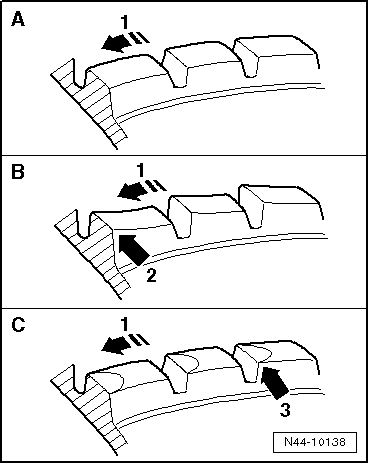
Extreme heel-and-toe wear may lead to customer complaints about noise.
Increased heel-and-toe wear occurs with:
- Toe values too great
- Incorrect air pressure
- Deep, open treads
- Tires which are not mounted on the tractive axle
- Extreme driving style around curves.
Non-Directional Tires
When heel-and-toe wear occurs, the direction of travel of the tire must be reversed. If increased heel-and-toe wear and rolling noise develop, the tires should be rotated diagonally. This leads to a reduction of heel-and-toe wear.
On vehicles with front wheel drive, this effect is increased by increased wear on front axle.
The rolling noise is somewhat louder immediately after rotating the wheels, but the normal noise level will be reached after traveling approximately 500 to 1,000 km (310.68 to 621.37 miles).
Directional Tires
In the event of increased heel-and-toe wear of the tires on the rear axle - most common with front-wheel drive - rotate the wheels from back to front. In the event of increased heel-and-toe wear on the outer edges on one axle, reverse both tires on their rims. Then the left wheel must be mounted on the right side and the right wheel on the left side.
High Speed Tires, Wear Characteristics
These tires are designed for the highest speeds. Good traction on wet roads is emphasized when developing these tires. Tread compounds do not have the abrasion resistance of tires for lower speeds, such as T and H tires.
Therefore the service life expectancy of high-speed tires is substantially lower under comparable operating conditions.
Tread Depth, Measuring
Note
- When measuring tread depth, take measurements in the main grooves.
- Do not take measurements at the tread wear indicator.
Tread depth of a tire must be measured in the main grooves at the points showing the most wear. The positions of the tread wear indicators are marked along the tire shoulder -item 2-.
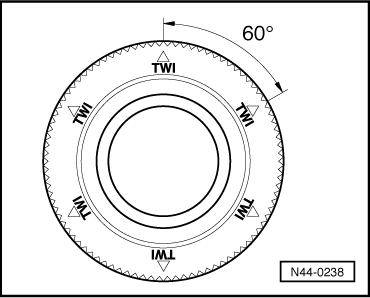
In place of "TWI", there may also be a "Δ" or "VW emblem".
The TWI protrusions are 1.6 mm tall. This is the minimum tread depth legally prescribed in Germany.
Different values may apply in other countries.
Tread Wear Indicators (TWI) must not be included in the measurement. The deepest point of the groove must be used for the measurement.
- Tread Wear Indicators in main grooves
- Main grooves with Tread Wear Indicators -arrows-
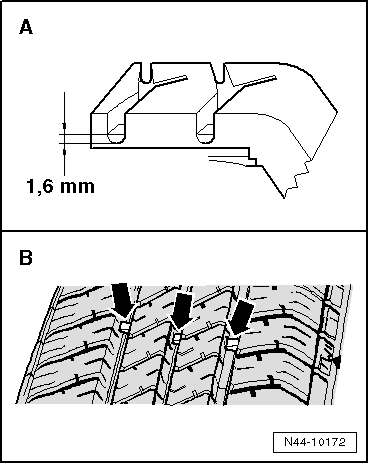
Tire Wear, One Sided
In many causes, this is caused by driving style, but sometimes it is also caused by incorrect axle adjustment.
Increased One-Sided Wear
One-sided wear, in conjunction with scrub marks on tread ribs and finer grooves, always appears when tires roll at an extreme slip angle and consequently "scrub" on the road surface.
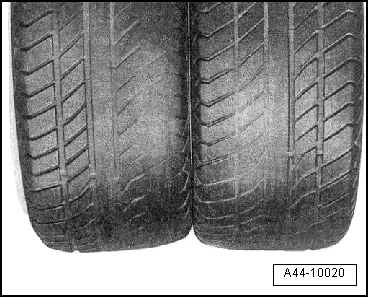
Driving quickly around curves leads to increased wear, especially on the outside edge.
A rounded tire shoulder in conjunction with especially high wear on the outer tread bars indicates fast driving around curves. This wear pattern is influenced by the driving style.
The suspension is adjusted to certain toe and camber values to optimize handling. When tires roll under conditions other than those specified, increased and one-sided wear must be expected.
Strong one-sided wear can be caused especially by incorrect toe and camber values. This increases the danger of diagonal wear spots.
Toe-Out or Negative Toe-In
The distance between the fronts of the tires -A- is greater than the distance between the backs of the tires -B- (-C- = direction of travel).
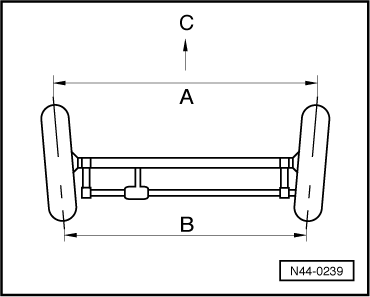
Toe-In or Positive Toe-In
The distance between the fronts of the tires -A- is less than the distance between the backs of the tires -B- (-C- = direction of travel).
To avoid one-sided tire wear, ensure that the wheel alignment remains within the tolerances specified by the vehicle manufacturer. The most common deviation of wheel alignment is caused by external influences, for example hard contact with the curb when parking.
A measurement of the axle geometry can determine whether the wheel alignment is within the specified tolerances or whether a correction of the wheel alignment is necessary.
Changes to the Suspension
If a "lowering-kit" and /or light alloy wheels from accessories which have not been recommended by the vehicle manufacturer are used, wheel alignments which deviate from the alignment specified in design may occur during travel.
Even if the adjustment of the axle geometry measured on a standing vehicle is correct, changes in the body height and positions of the wheels during travel can lead to changes to the paths of travel of the wheel suspension.
For this reason, uneven wear is pre-programmed.
Improper Use of Air Suspension Height Adjustment
The use of off road levels is only recommended when driving off road. The permanent use of off road levels on normal roads can lead to increased tire wear because the changed height changes the wheel alignment relative to the road level.
To Prevent One-Sided Tire Wear, Correct Axle Geometry Adjustment Should Be Ensured On the One Hand, and Intended Use of the Vehicle on the Other Hand.
Good vehicle and tire maintenance helps to prevent tire wear. The following points should especially be observed.
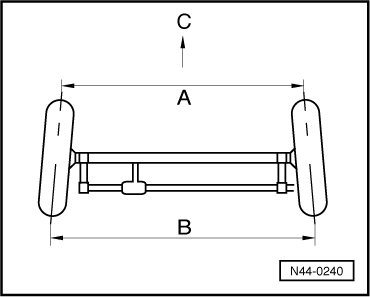
- The specified minimum tire pressures must be maintained.
- Different wear on front and rear axle cannot be avoided depending on driving style. This can be counteracted by regular tire rotation. This lends itself, for example, to the rotational change from summer to winter tires and back. This change has the positive side effect of all tires wearing evenly so a complete set of new tires can be installed. This prevents use of different tire tread depths on both axles, which can have negative effects on driving behavior.
- The formation of heel and toe wear is a normal wear pattern, particularly with a very smooth driving style. This could result in a louder rolling noise which are generally improved with increased tread depth. If heel and toe wear is light or is still forming, exchanging tires on both sides is generally sufficient. With strong heel and toe wear, tires should be rotated according to so that their direction of travel is reversed. This does not apply to non-directional tires!
- On some tire profiles, the effect of premature wear can be detected visually: If winter tire ribs or profile recesses have been worn off, only compact profile blocks without tread pattern, which gives the impression of a worn tire. In this case, the remaining profile depth in each tread groove must be measured. If it is greater than the legally required minimum tread depth (Germany 1.6 mm; it is recommended to use winter tries with a remaining profile of 4 mm only in summer use [regulation in Austria]), the tires can be reused without restrictions.
Tire Wear, Outer Shoulder
Improper Use of Air Suspension Height Adjustment
The use of off road levels is only recommended when driving off road. The permanent use of off road levels on normal roads can lead to increased tire wear because the changed height changes the wheel alignment relative to the road level.
To Prevent One-Sided Tire Wear, Correct Axle Geometry Adjustment Should be Ensured On the One Hand, and Intended Use of the Vehicle on the Other Hand.
Good vehicle and tire maintenance helps to prevent tire wear. The following points should especially be observed.
- The specified minimum tire pressures must be maintained.
- Different wear on front and rear axle cannot be avoided depending on driving style. This can be counteracted by regular tire rotation. This lends itself, for example, to the rotational change from summer to winter tires and back. This change has the positive side effect of all tires wearing evenly so a complete set of new tires can be installed. This prevents use of different tire tread depths on both axles, which can have negative effects on driving behavior.
- The formation of heel and toe wear is a normal wear pattern, particularly with a very smooth driving style. This could result in a louder rolling noise which are generally improved with increased tread depth. If heel and toe wear is light or is still forming, exchanging tires on both sides is generally sufficient. With strong heel and toe wear, tires should be rotated according to so that their direction of travel is reversed. This does not apply to non-directional tires!
- On some tire profiles, the effect of premature wear can be detected visually: If winter tire ribs or profile recesses have been worn off, only compact profile blocks without tread pattern, which gives the impression of a worn tire. In this case, the remaining profile depth in each tread groove must be measured. If it is greater than the legally required minimum tread depth (Germany 1.6 mm; it is recommended to use winter tries with a remaining profile of 4 mm only in summer use [regulation in Austria]), the tires can be reused without restrictions.
Diagonal Washouts
Diagonal wear spots on tires
Diagonal wear spots run at an angle of approximately 45º with respect to the plane of circumference.
They usually occur once, but may also occur several times along the tire circumference.
Wear spots appear almost exclusively on the non-tractive tires, especially the rear left tire. There are vehicle models where wear spots appear rounded, which are not a problem. The effect is increased by high toe values. Toe values at the lower tolerance limit of the specified value improve the wear pattern.
The tire component integration is often found in the area with the most pronounced diagonal wear spots.
Wheels with toe-in roll with a slip angle even when the vehicle is traveling straight ahead. This leads to diagonal tension in the contact zone between tires/road surface.
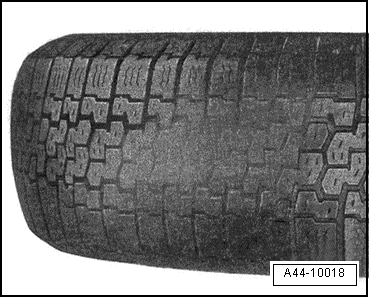
Driving with reduced tire pressure will improve the wear pattern. To prevent such wear patterns, the toe values of both rear wheels should be the same and the specified tire pressure should be maintained.
If wear spots are detected, mount the wheels on the tractive axle if the wear spots are still in the initial stage. Deeper wear spots are irreparable.
Faulty Adjustment
When a customer complains of "diagonal wear spots", the toe adjustment must be checked. If it is OK, the cause for the diagonal wear spots is most likely in the tires.
Tires with diagonal wear spots which developed due to faulty adjustment of the axle geometry are excluded from the warranty.
Tire Wear, Center
This wear pattern is found on drive wheels on high-powered vehicles that often drive long stretches at high speed.
At high speeds, the centrifugal force increases the tire diameter at the center of the tread more than at the shoulders of the tire. The drive forces from the center area of the tread are transferred to the road surface. This is reflected in the wear pattern.
These effects can appear especially extreme on wide tires.
Reducing the Tire Pressure is Not an Effective Remedy for this Wear Pattern.
WARNING
For safety reasons, tire pressure must never be lowered below specified pressure under any circumstances.
A largely even wear pattern can be achieved if tires are changed in a timely manner from the tractive to the non-tractive axle.
Increased Tread Wear
Typical wear pattern of tires on the tractive axle of high-powered vehicles.
The increased wear at the tread center is caused by stresses related to the centrifugal force of the tire and the transmission of traction forces.
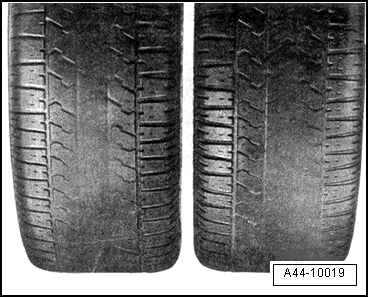
Permitted Tread Depth - Variance
- For all four wheels use only tires of the same construction type, and tread.
- Always use tires with the deepest tread depth on the front axle.
- Replacing one individual tire is always possible. The vehicle manufacturer recommends at the very least however that the tires are replaced on both sides of the axle.
- With sport differential on the rear axle, the vehicle manufacturer recommends always replacing the tires on both sides of the rear axle.
Note
The technical background of the limitations are thermal pressure for the transmission oil due to a large difference in the rolling circumference of the tires.
The Difference Between the Front and Rear Axle, must Not be Greater Than 3 mm.
Example:
| Front axle left tire tread depth | Front axle right tire tread depth | Average front axle tread depth | Difference of the front axle to the rear axle |
| 2.0 mm | 2.0 mm | 2.0 mm from left to right | 3.0 mm |
| Rear axle left tire tread depth | Rear axle right tire tread depth | Average rear axle tread depth | Within the permissible tolerance |
| 3.0 mm | 7.0 mm (new tire) | 5.0 mm from left to right |
 Tires, Evaluating
Tires, Evaluating
Flat Spots
What is a Flat Spot From Standing?Terms like flat portion, flattening,
are also used as a term for flat spots from standing.Flat spots from standing
cause vibration, like an incorrectly b ...
 Component Overview
Component Overview
Overview - Wheel
Overview - Wheel, Standard
Wheel
Installing the wheel.
Wheel Bolts
There are different versions.
Tires
Refer to
→ Chapter "Tire Information"
Valve ...
See More:
Volkswagen Tiguan Service and Repair Manual > Subframe, Final Drive, AWD: Subframe, Servicing, through 05/2012
Special tools and workshop equipment required
Tensioning Strap -T10038-
Locating Pins -T10096-
Hydraulic Press - Rear Subframe Bushing Tool Kit -T10263-
Engine and Gearbox Jack -VAS6931-
Hydraulic Press -VAS6178- with Bearing Installer - Wheel Hub/Bearing
Kit- Pressure Head -T10205/13-
Pneu ...
Volkswagen Tiguan Owners Manual
Volkswagen Tiguan Service and Repair Manual
- Body exterior
- Body Interior
- General Paint Information
- Paint
- Brake System
- Suspension, Wheels, Steering
- Wheel and Tire Guide
- Towing Guide
- Wheel and Tire Guide General Information
- Communication
- Electrical Equipment General Information
- Electrical Equipment from 06/2011
- Heating, Ventilation and Air Conditioning
- Refrigerant R134a Servicing
- 6-Speed Manual Transmission 02Q, OBB, and OFB
